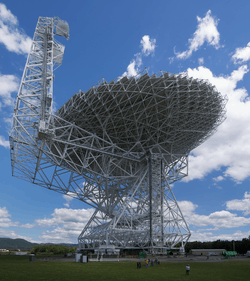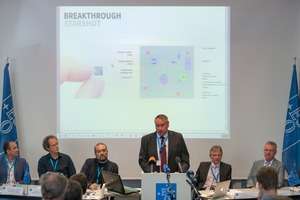Breakthrough Initiatives
Breakthrough Initiatives is a science-based program founded in 2015 and funded by Yuri Milner to search for extraterrestrial intelligence over a span of at least 10 years. The program is divided into multiple projects. Breakthrough Listen will comprise an effort to search over 1,000,000 stars for artificial radio or laser signals. A parallel project called Breakthrough Message is an effort to create a message "representative of humanity and planet Earth".[1][2] The project Breakthrough Starshot aims to send a swarm of probes to the nearest star at about 20% the speed of light. The project Breakthrough Watch aims to identify and characterize Earth-sized, rocky planets around Alpha Centauri and other stars within 20 light years of Earth.[3]
History
The Breakthrough Initiatives were announced to the public on July 20, 2015, at London's Royal Society. Physicist Stephen Hawking, Russian tycoon Yuri Milner, and others created the Initiatives to search for intelligent extraterrestrial life in the Universe and consider a plan for possibly transmitting messages out into space.[4][5] The announcement included an open letter co-signed by multiple scientists, including Hawking, expressing support for an intensified search for alien radio communications. During the public launch, Hawking said: "In an infinite Universe, there must be other life. There is no bigger question. It is time to commit to finding the answer."[6][7]
The US$100 million cash infusion is projected to mark up the pace of SETI research over the early 2000s rate, and will nearly double the rate NASA was spending on SETI research annually in approximately 1973–1993.[5]
Projects
Breakthrough Listen

Breakthrough Listen is a program to search for intelligent extraterrestrial communications in the Universe.[4][6][8] With $100 million in funding and thousands of hours of dedicated telescope time on state-of-the-art facilities, it is the most comprehensive search for alien communications to date.[6][9] The project began in January 2016, and is expected to continue for 10 years.[10]
The project uses radio wave observations from the Green Bank Observatory and the Parkes Observatory, and visible light observations from the Automated Planet Finder.[11] Targets for the project include one million nearby stars and the centers of 100 galaxies. All data generated from the project are available to the public, and SETI@Home is used for some of the data analysis. The first results were published in April 2017, with further updates expected every 6 months.
Breakthrough Message
The Breakthrough Message program is to study the ethics of sending messages into deep space.[12] It also launched an open competition with a US$1 million prize pool, to design a digital message that could be transmitted from Earth to an extraterrestrial civilization. The message should be "representative of humanity and planet Earth". The program pledges "not to transmit any message until there has been a global debate at high levels of science and politics on the risks and rewards of contacting advanced civilizations".[13]
Breakthrough Starshot

Breakthrough Starshot, announced April 12, 2016, is a US $100 million program to develop a proof-of-concept light sail spacecraft fleet capable of making the journey to Alpha Centauri at 20% the speed of light (60,000 km/s or 215 million km/h) taking about 20 years to get there,[14][15] and about 4 years to notify Earth of a successful arrival.[14][16][17]
The interstellar journey may include a flyby of Proxima Centauri b, an Earth-sized exoplanet that is in the habitable zone of its host star in the Alpha Centauri system.[18] From a distance of 1 Astronomical Unit (150 million kilometers or 93 million miles), the four cameras on each of the spacecraft could potentially capture an image of high enough quality to resolve surface features.[19] The spacecraft fleet would have 1000 craft, and each craft, named StarChip,[20] would be a very small centimeter-sized craft weighing several grams.[20] They would be propelled by several ground-based lasers of up to 100 gigawatts.[21] Each tiny spacecraft would transmit data back to Earth using a compact on-board laser communications system.[21] Pete Worden is the head of this project.[22][23] The conceptual principles to enable this interstellar travel project were described in "A Roadmap to Interstellar Flight", by Philip Lubin of UC Santa Barbara.[24][25] METI president Douglas Vakoch summarized the significance of the project, saying that "by sending hundreds or thousands of space probes the size of postage stamps, Breakthrough Starshot gets around the hazards of spaceflight that could easily end a mission relying on a single spacecraft. Only one nanocraft needs to make its way to Alpha Centauri and send back a signal for the mission to be successful. When that happens, Starshot will make history."[26]
In July 2017, scientists announced that precursors to StarChip, named Sprites, were successfully launched and flown.[27]
Breakthrough Watch
Breakthrough Watch is a multimillion-dollar astronomical program to develop Earth- and space-based technologies that can find Earth-like planets in our cosmic neighborhood – and try to establish whether they host life.[28] The project aims to identify and characterize Earth-sized, rocky planets around Alpha Centauri and other stars within 20 light years of Earth, in search of oxygen and other "biosignatures."[3]
See also
- Active SETI
- Colossus Array Array of 74m telescopes capable of laser propelling nano crafts.
- Communication with extraterrestrial intelligence
- Interstellar probe
- Interstellar travel
- IXS Enterprise
- Nexus for Exoplanet System Science
- Ohio State University Radio Observatory
- 100 Year Starship
- Open data
- Open-source software
- Project Daedalus
- Project Dragonfly
- Project Icarus
- Project Longshot
- Search for extraterrestrial intelligence
- SETI@home
- Starship
- Starwisp
References
- ↑ Lendino, Jamie (20 July 2015). "Stephen Hawking, Milner unveil $100M initiative to 'dramatically accelerate' search for alien life". ExtremeTech. Retrieved 20 July 2015.
- ↑ Johnson, Steven (28 June 2017). "Greetings, E.T. (Please Don't Murder Us.)". New York Times. Retrieved 28 June 2017.
- 1 2 "Breakthrough Initiatives". breakthroughinitiatives.org. Retrieved 2017-06-09.
- 1 2 Feltman, Rachel (20 July 2015). "Stephen Hawking announces $100 million hunt for alien life". Washington Post. Retrieved 20 July 2015.
- 1 2 Billings, Lee (20 July 2015). "Search for Extraterrestrial Intelligence Nets Historic Cash Infusion". Scientific American. Retrieved 21 July 2015.
- 1 2 3 Merali, Zeeya (20 July 2015). "Search for extraterrestrial intelligence gets a $100-million boost. Russian billionaire Yuri Milner announces most comprehensive hunt for alien life". Nature News. Retrieved 20 July 2015.
- ↑ Vella, Matt (21 July 2015). "Read the Inspiring 'Questions of Existence' Letter from the World's Greatest Thinkers". Time. Retrieved 21 July 2015.
- ↑ Rundle, Michael (20 July 2015). "$100m Breakthrough Listen is 'largest ever' search for alien civilisations". Wired. Retrieved 20 July 2015.
- ↑ Rundle, Michael (20 July 2015). "$100m Breakthrough Listen is 'largest ever' search for alien civilisations". Wired. Retrieved 20 July 2015.
- ↑ "Breakthrough Initiatives". breakthroughinitiatives.org. Retrieved 2017-06-09.
- ↑ Sample, Ian (20 July 2015). "Anybody out there? $100m radio wave project to scan far regions for alien life". The Guardian. Retrieved 20 July 2015.
- ↑ Rundle, Michael (20 July 2015). "$100m Breakthrough Listen is 'largest ever' search for alien civilisations". Wired. UK. Retrieved 29 July 2015.
- ↑ "Breakthrough Initiatives". www.breakthroughinitiatives.org. Retrieved 24 July 2015.
- 1 2 Stone, Maddie (April 12, 2016). "Stephen Hawking and a Russian Billionaire Want to Build an Interstellar Starship". Gizmodo. Retrieved 12 April 2016.
- ↑ Staff (12 April 2016). "Breakthrough Initiatives - Breakthrough Starshot". Breakthrough Initiatives. Retrieved 14 April 2016.
- ↑ Overbye, Dennis (12 April 2016). "Reaching for the Stars, Across 4.37 Light-Years; A Visionary Project Aims for Alpha Centauri, a Star 4.37 Light-Years Away". New York Times. Retrieved 12 April 2016.
- ↑ "Breakthrough Starshot". Breakthrough Initiatives. 12 April 2016. Retrieved 12 April 2016.
- ↑ Chang, Kenneth (24 August 2016). "One Star Over, a Planet That Might Be Another Earth". New York Times. Retrieved 24 August 2016.
- ↑ Starshot - Target
- 1 2 Gilster, Paul (12 April 2016). "Breakthrough Starshot: Mission to Alpha Centauri". Centauri Dreams. Retrieved 14 April 2016.
- 1 2 Starshot - Concept.
- ↑ Billionaire Milner pledges $100 million to find intelligent life in space". Reuters. 20 July 2016.
- ↑ https://breakthroughinitiatives.org/News
- ↑ Lubin, Philip (April 2015). "A Roadmap to Interstellar Flight" (PDF). Journal of the British Interplanetary Society (published February 2016). 69: 40–72. Retrieved 11 January 2016.
- ↑ Hall, Loura (May 7, 2015). "DEEP IN Directed Energy Propulsion for Interstellar Exploration". NASA News. Retrieved 2016-04-22.
NASA is pleased to hear that Professor Lubin has received external funding to continue the work started in his NIAC study.
- ↑ Osborne, Hannah (2016-04-12). "Alpha Centauri mission: Stephen Hawking and Yuri Milner plan to send tiny spacecrafts to the stars". International Business Times UK. Retrieved 2017-05-01.
- ↑ Staff (26 July 2017). "In Quest To Reach Alpha Centauri, BreakThrough Starshot Launches World's Smallest Spacecraft - First Prototype 'Sprites' – Precursors to Eventual 'StarChip' Probes – Achieve Low Earth Orbit". BreakThroughInitiatives.org. Retrieved 28 July 2017.
- ↑ "Breakthrough Initiatives". breakthroughinitiatives.org. Retrieved 2017-06-09.
External links
- Breakthrough Initiatives web site
- Yuri Milner and Stephen Hawking announce $100 million Breakthrough Initiative to dramatically accelerate search for intelligent life in the Universe / Breakthrough Initiatives, London, July 20, 2015
- Breakthrough Listen, Breakthrough Initiatives website
- Breakthrough Initiatives' official website
- Launching a StarChip - concept on YouTube
- Going interstellar (NASA) on YouTube
- Will Starshot's Insterstellar Journey Succeed? (PBS Digital Studios) on YouTube
- Official website
- http://www.pesti.net Creation of Stephen Hawking's Universe with Nanotechnology
